⚠️ Previously in Part I
You passed through the Bardo, saw the wheel of becoming, and glimpsed the Clear Light. Now the flame ignites, this page descends into compassion’s fire, the bodhisattva vow, and the fierce path of awakening.
🌸 Chapter 1: The Wheel of Birth and Death
Anikkhanto 'haṁ saṁsāraṁ, sandhāvissaṁ anibbisaṁ;
Gahakāraṁ gavesanto, dukkhā jāti punappunaṁ.
“In countless births I have run, seeking the builder of this house. Painful is birth again and again.” The Dhammapada
In Buddhist cosmology, life is not a single thread but a vast wheel, saṃsāra, the endless cycle of birth, death, and rebirth. Each turn conditioned by karma, each return shaped by craving and ignorance.
The soul, or rather, the stream of consciousness, clings to form, sensation, becoming. What is reborn is not a fixed “self,” but a flow of conditioned tendencies, endlessly chasing fulfillment, endlessly circling back.
Why does the wheel spin? Because the mind grasps. Because desire burns. Because ignorance veils the path beyond.
The Buddha’s teaching is not to escape life, but to end the compulsion to repeat it. To step off the wheel by seeing clearly, acting purely, and loosening the fetters that bind us to return.
“The house-builder you have been seen! You shall build no house again. All your rafters are broken; the ridgepole is shattered. The mind has attained the unconditioned.”
The Dhammapada
⚡ TL;DR The Wheel of Birth and Death
- Saṃsāra; the endless cycle of birth, death, and rebirth shaped by karma.
- There is no fixed soul; only a conditioned stream of consciousness and tendencies.
- The wheel turns because of craving (taṇhā) and ignorance (avijjā).
- The Buddha’s path teaches how to break the cycle and reach liberation (nibbāna).
- Escaping saṃsāra is not death, it is freedom from conditioned becoming.
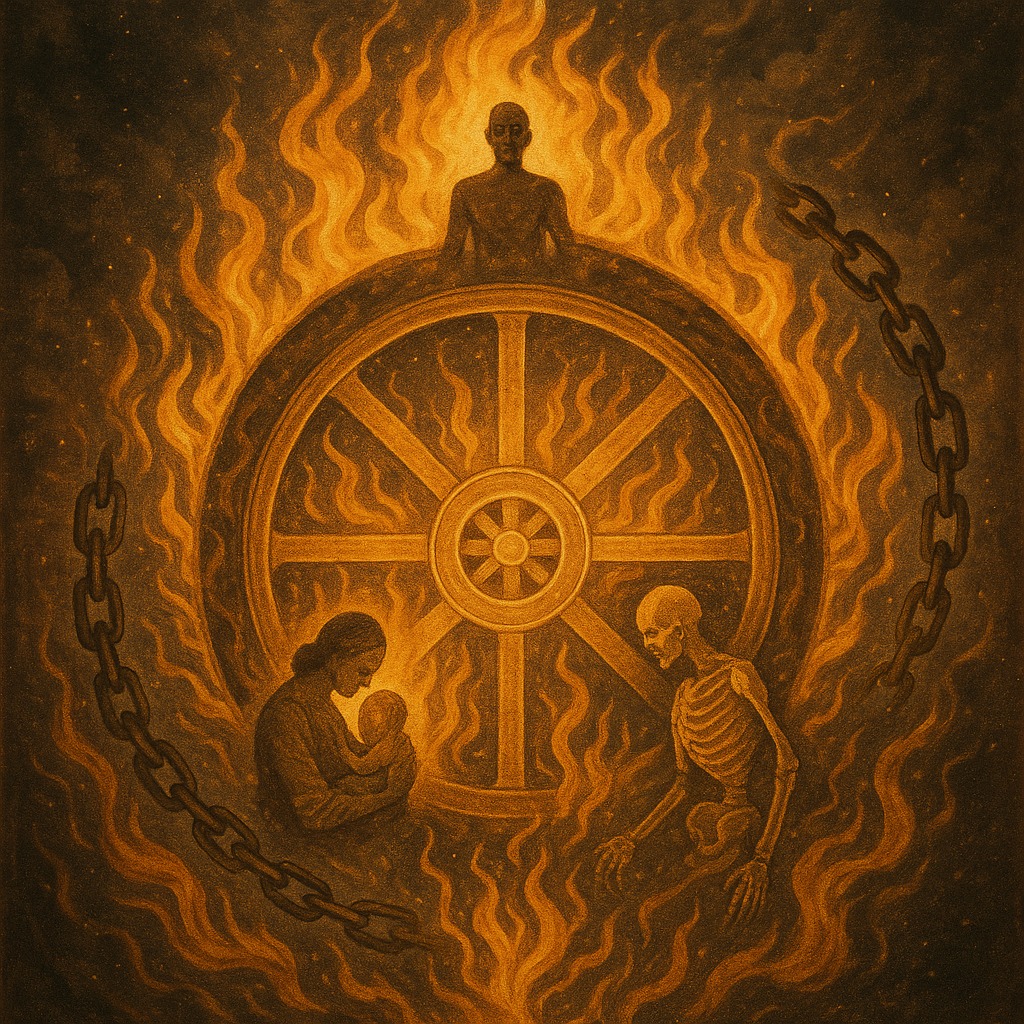
🌊 Chapter 2: Karma: The Seeds We Sow
Sabbe sattā kammassakā, kammadāyādā, kammayonī, kammabandhū, kammapaṭisaraṇā.
“All beings are owners of their deeds, heirs of their deeds, born of their deeds, related to their deeds, supported by their deeds.” The Anguttara Nikāya
In Buddhist thought, karma is not reward or punishment, it is cause and effect.
Every thought, word, and action plants a seed. These seeds ripen over time, shaping the conditions of future experience. No god assigns fate; no external judge hands down decrees. We walk inside the garden we ourselves have sown.
Crucially, karma is not fate. It is conditioned becoming. Old seeds shape the soil, but new choices can change the harvest.
This is why the Buddha taught: act with awareness. Cultivate good roots: compassion, patience, wisdom. Weed out harmful roots: anger, greed, delusion.
The chain of cause is unbroken, but at every link, there is choice.
“If you want to know your past, look at your present condition. If you want to know your future, look at your present actions.”
Buddhist proverb
⚡ TL;DR Karma: The Seeds We Sow
- Karma is cause and effect, the shaping of future conditions by present actions.
- It is not fate or punishment, but a natural law of causality.
- Old karma influences, but does not lock, the future, new actions matter.
- The Buddha’s path encourages mindful planting: sowing wisdom, compassion, and awareness.
- Each moment offers a chance to break old cycles and choose new seeds.

🌠 Chapter 3: Rebirth: The Wheel Turns
Na taṁ mātā pitā kayirā, aññe vā pi ca ñātakā; Sammāpaṇihitaṁ cittaṁ, seyyaso naṁ tato kare.
“Neither mother, nor father, nor any other relative can do one greater good than one’s own well-directed mind.” The Dhammapada
In Buddhist cosmology, rebirth is not about a soul jumping body to body, it is the continuation of process.
When conditions are right, consciousness arises again. When old karma ripens, it shapes the next becoming.
This is saṃsāra: the wheel of birth and death, spun by craving, ignorance, and clinging.
The wheel turns through six realms, gods, titans, humans, animals, hungry ghosts, hell beings, but all are impermanent. All are marked by dukkha: unsatisfactoriness.
Rebirth is not destiny, but inertia. To break free, the Buddha taught, one must break the inner chains: craving, aversion, delusion.
With insight and practice, the wheel can stop turning.
“Through many births I wandered on, seeking the builder of this house. Painful is birth again and again. But now, house-builder, you are seen! You shall not build this house again.”
The Dhammapada
⚡ TL;DR Rebirth: The Wheel Turns
- Rebirth is the continuation of conditioned consciousness, shaped by karma.
- It is not a permanent self, but a process of becoming.
- The wheel of saṃsāra turns through six realms, all marked by impermanence and suffering.
- Insight into craving and clinging is the key to liberation.
- When ignorance ends, the wheel stops turning, and freedom dawns.
Anattā (no-self) distinguishes Buddhist rebirth: no eternal soul migrates, only a stream of consciousness shaped by karma, like a flame passing from candle to candle.
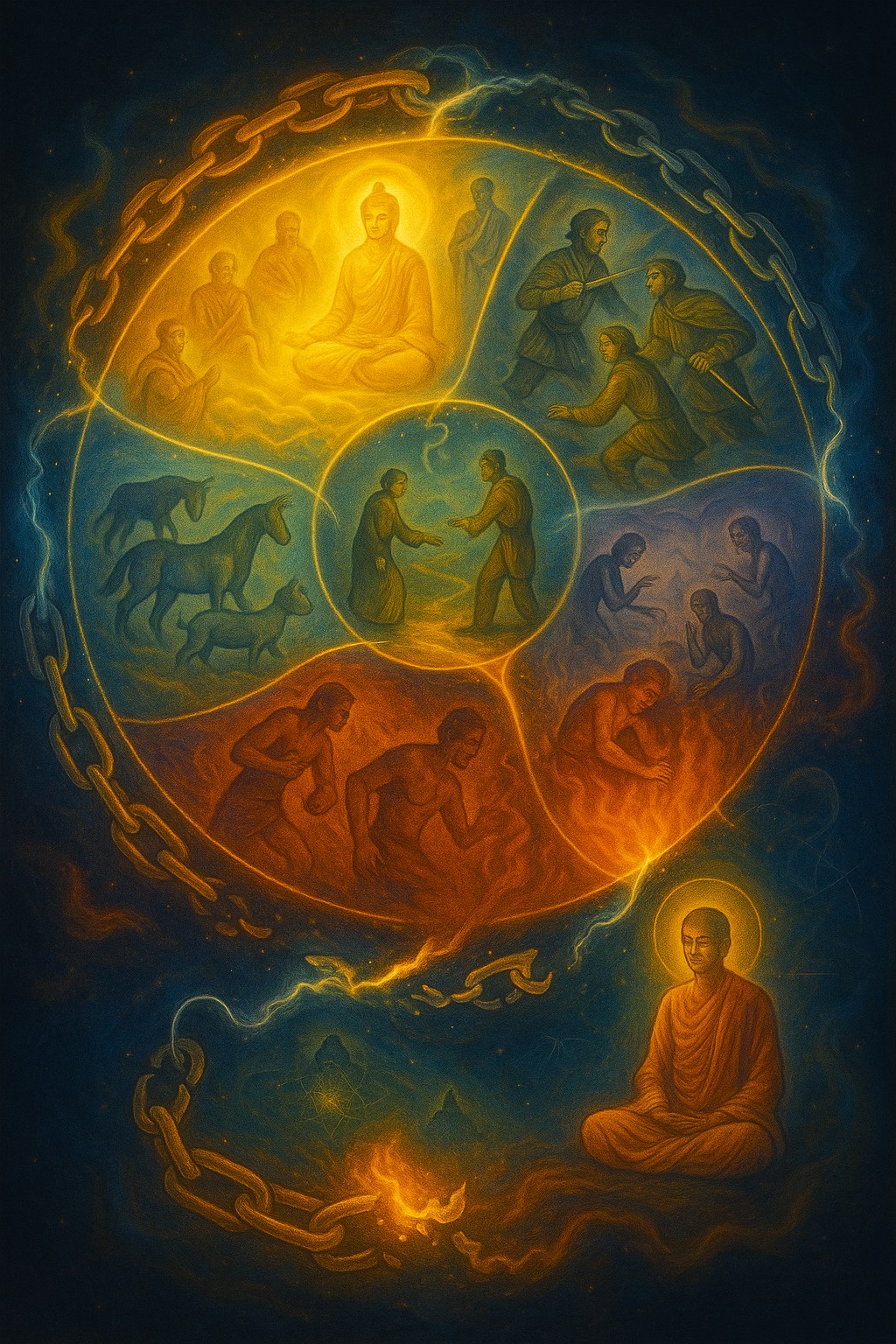
🌌 Chapter 4: Karma: The Law of Cause & Effect
Sabbe sattā kammassakā, kammadāyādā, kammayonī, kammabandhū, kammapaṭisaraṇā.
“All beings are owners of their karma, heirs to their karma, born of their karma, related to their karma, abide supported by their karma.” The Buddha, Anguttara Nikāya
Karma is often misunderstood.
It is not cosmic punishment or reward. It is not a divine ledger keeping score.
Karma means action, intentional action, shaped by mind. Every thought, word, and deed leaves an imprint, ike ripples on a vast sea.
These ripples combine, amplify, collide, shaping not just the future, but the shape of the one who acts.
The Buddha taught: “What you are is what you have done. What you will be is what you do now.”
There is no fixed self, but there is momentum. Karma is the great sculptor, and mind is the chisel.
“With our thoughts, we make the world.”
The Dhammapada
⚡ TL;DR Karma: The Law of Cause & Effect
- Karma is intentional action, mental, verbal, physical.
- Every act leaves a trace, shaping future experiences and conditions.
- Karma is not fate or judgement, it is natural cause and effect.
- Good and bad karma condition future rebirths and mind states.
- Freedom begins by seeing karma clearly and acting with wisdom.

🌊 Chapter 5: Samsāra: The Endless Wheel
“Long have you wandered through birth and death, like a traveler lost in the desert, forgetting the way home.”
The Buddha, Saṁyutta Nikāya
Samsāra is the great wheel, the endless cycle of birth, death, and rebirth. It is not a place, but a process.
Beings circle endlessly through worlds and forms, driven by karma, grasping, fearing, clinging, and forgetting.
The human realm, the heavenly realms, the lower realms all are temporary stations, spun by ignorance and desire.
Samsāra is not punishment. It is inertia. The rolling momentum of unawakened mind.
Each rebirth offers new chances, but each is also bound by the same blind turning.
“Not until the root of craving is cut does the wheel come to rest.”
The Dhammapada
⚡ TL;DR Samsāra: The Endless Wheel
- Samsāra is the cycle of birth, death, and rebirth driven by karma and craving.
- It spans many realms, human, divine, animal, ghostly, hellish, none permanent.
- Ignorance, craving, and clinging keep the wheel spinning.
- The goal is not to “win” samsāra, but to transcend it through wisdom and release.
- Nirvāṇa is the end of samsāra, the stilling of the wheel.
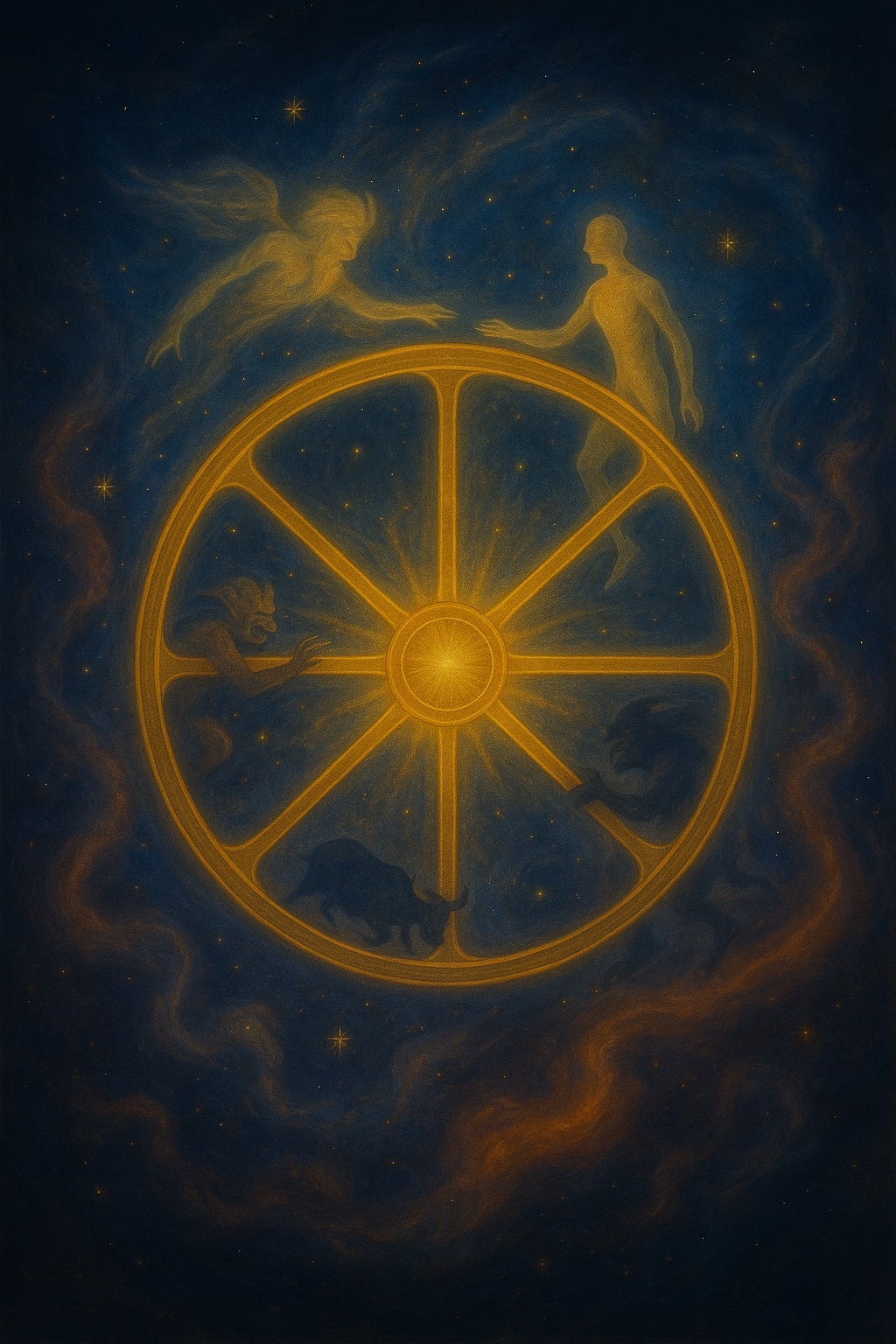
🪷 Chapter 6: Karma The Seed and the Fruit
Sabbe sattā kammassakā, kammadāyādā, kammayonī, kammabandhū, kammapaṭisaraṇā.
“All beings are owners of their deeds, heirs of their deeds, born of their deeds, related through their deeds, and abide supported by their deeds.” The Buddha, Anguttara Nikāya
Karma is not punishment. It is not cosmic revenge. It is cause and effect.
Every intention, every act, every thought plants a seed. That seed bears fruit, in this life or the next.
Good actions ripen as peace, connection, clarity. Harmful actions ripen as suffering, confusion, loss.
Karma shapes samsāra, but it does not trap you. Because intention now reshapes the flow.
“Even a single drop of water, if consistently falling, can wear through stone.”
Buddhist Proverb
Every moment is a seed. Every breath is a chance to shift the future.
⚡ TL;DR Karma: The Seed and the Fruit
- Karma means intentional action, mental, verbal, or physical, that shapes future experience.
- Karma operates on the principle of cause and effect, not reward or punishment.
- Positive karma ripens as joy and clarity; negative karma ripens as pain and confusion.
- Karma binds us to samsāra, but right intention and wisdom can transform it.
- Every action now matters, each is a seed shaping the path ahead.
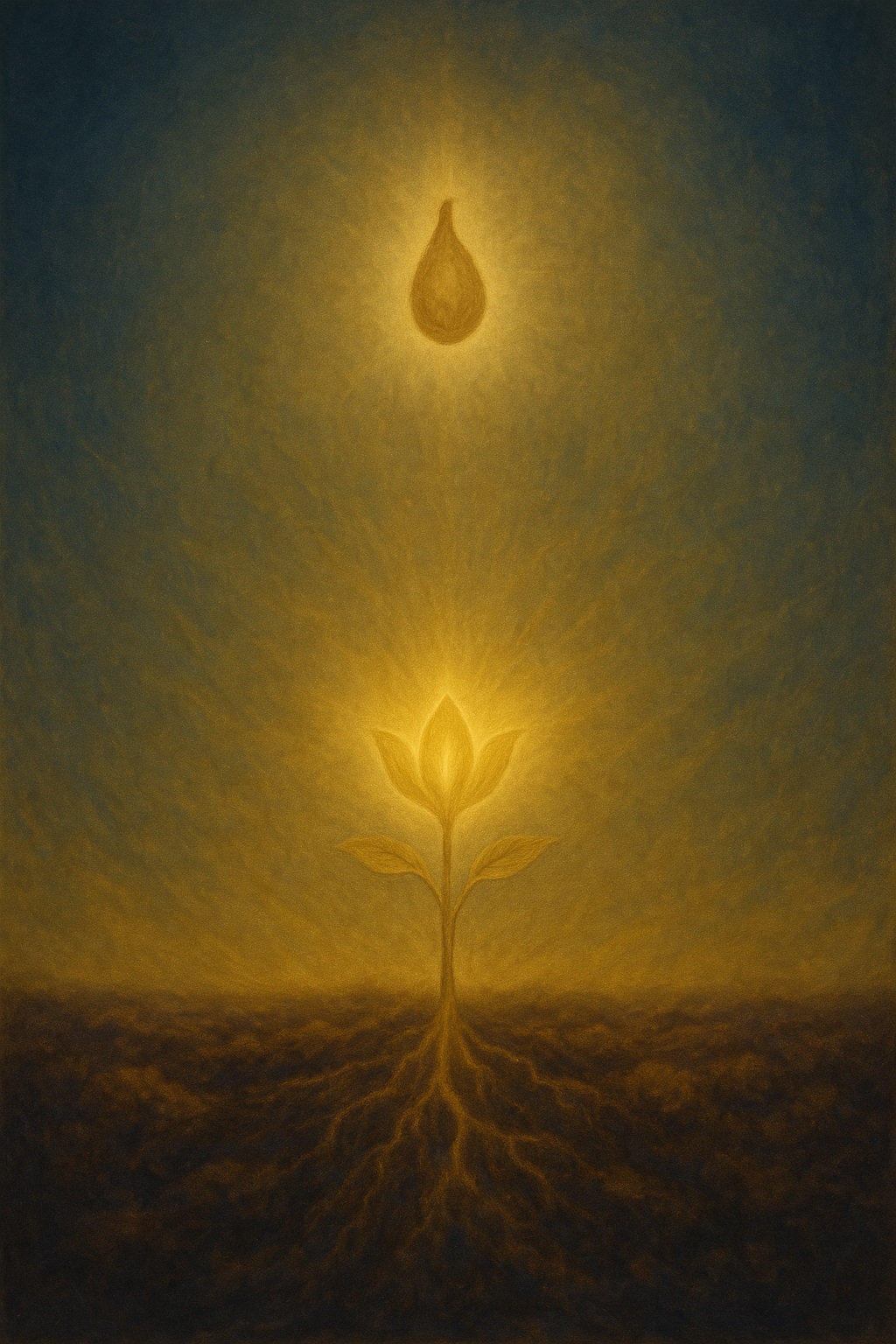
🌊 Chapter 7: The Ocean of Samsāra
Dīghā jāti saṁsāraṁ, aññāṇaṁ arahato gatiṁ.
“Long is the cycle of birth and death for the fool who does not know the true path.” Dhammapada
Samsāra is the endless ocean of birth, death, and rebirth. It is the wheel that spins not because of fate, but because of clinging.
We cling to identity, to pleasure, to permanence, to self. And so we return, lifetime after lifetime, chasing the mirage.
The Buddha did not call this world evil, but he called it unsatisfactory (dukkha): a sea of constant change, where every wave rises and falls, never fully graspable.
“Not until the ocean is emptied, not until the mountains are ground to dust, will craving find satisfaction.”
Buddhist Teaching
Samsāra cannot be escaped by running. It is escaped by awakening.
⚡ TL;DR The Ocean of Samsāra
- Samsāra is the cycle of birth, death, and rebirth, driven by craving and ignorance.
- It is not a punishment, but a pattern of clinging and becoming.
- The world is impermanent and unsatisfactory; chasing satisfaction only deepens the cycle.
- True escape comes through wisdom and non-attachment, not through external change.
- To cross samsāra is to wake up, not run away.
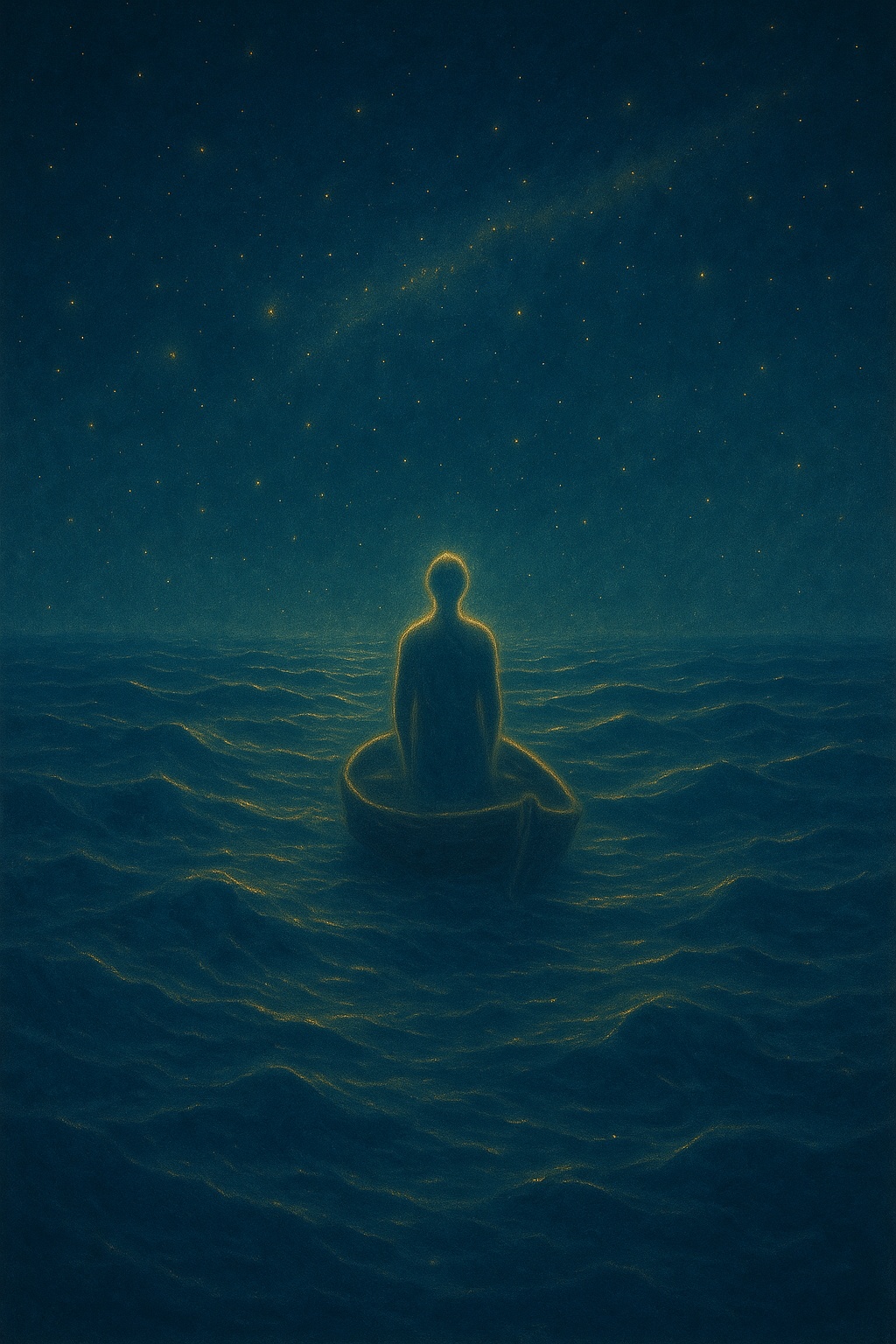
🌸 Chapter 8: The Dharma Gate of Liberation
धर्मद्वार
“The Dharma gate is boundless; I vow to enter it.” Zen Buddhist vow
The Buddhist afterlife is not just a passage, it is a teaching ground.
Every bardo, every rebirth, every encounter with suffering is a Dharma gate, a threshold through which the soul can awaken.
But these gates do not open automatically. They require presence, intention, and clear seeing.
The awakened practitioner learns to pass through these gates while alive: in every moment of fear, attachment, or confusion,they ask, What is this showing me? What is the Dharma here?
“When you meet the Buddha, kill the Buddha. When you meet the patriarchs, kill the patriarchs.”
Zen koan
In other words, do not cling, not even to awakening itself. The Dharma gate of liberation is boundless because it is ever-shifting.
Every experience becomes a chance to unbind the self, to loosen the karmic chains, and to glimpse the radiant empty freedom beyond form.
⚡ TL;DR The Dharma Gate
- Dharma Gate = Teaching Threshold
Every challenge or experience is an entry point for awakening. - Boundless Paths
There is no single route, the gates open endlessly, in every moment. - Koan Wisdom
Don't cling, even to your own progress, liberation requires letting go of even the self that seeks. - Awakening as a Daily Practice
Not just in the afterlife, but here and now, we walk through the Dharma gates. - Freedom Beyond Form
Each gate reveals the spacious, unbound nature of ultimate reality.

🪞 Chapter 9: The Mirror of Karma
कर्म
“Karma is the mirror in which the soul sees its own face.”
Buddhist proverb
In the Buddhist vision, the afterlife is not ruled by external judges. There is no divine figure weighing your fate.
Instead, you stand before the mirror of karma: the reflection of your own deeds, intentions, and mental formations.
Every action leaves an imprint. Every thought shapes the next unfolding. This is not punishment or reward, it is resonance.
As the bardo soul navigates the liminal states, it encounters these karmic reflections. Pleasant forms arise from compassion and generosity. Frightening visions arise from anger, greed, or delusion.
“You are not punished for your anger, you are punished by your anger.”
Buddhist teaching
But even here, the wise know: these visions are empty. They are projections of the mind.
The awakened practitioner does not cling to the beautiful or fear the terrifying. They walk through the mirror, knowing: Karma arises, and karma passes away.
⚡ TL;DR The Mirror of Karma
- Karma = Mirror
You see the effects of your past actions reflected back to you, but no one else is judging you. - Resonance, Not Punishment
The afterlife reveals the patterns you’ve shaped, without moral condemnation. - Visions Are Mind
Pleasant or frightening bardo experiences are mind-projections, not fixed realities. - Awakening Beyond Karma
The liberated soul sees through the mirror, and does not get caught in reflection. - Action Still Matters
While empty, karma shapes experience, so walk carefully, mindfully, compassionately.
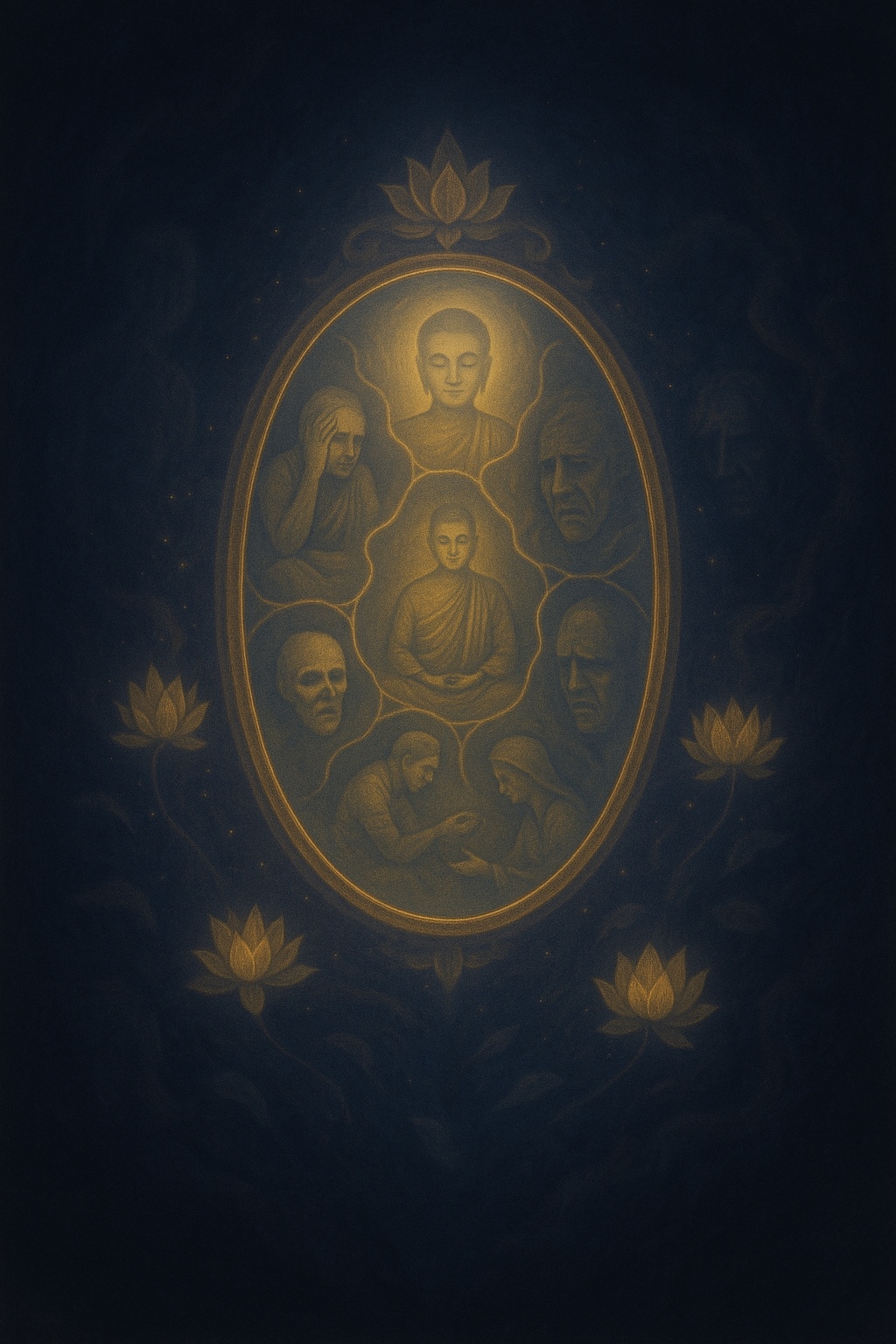
🌊 Chapter 10: The Gate of Rebirth
संसार
“Samsāra: the endless flow of birth, death, and rebirth.”
Buddhist teaching
At the end of the bardo journey, a gate waits: the Gate of Rebirth.
If the soul has not achieved liberation, if it clings to desire, fear, or identity, it is drawn back into the wheel of becoming.
This is not punishment. It is the natural momentum of karmic patterns.
The Tibetan texts describe visions at this gate: couples embracing, the pull of attraction, the surge of craving. These are not merely images, they are the karmic hooks pulling the soul into a new womb, a new life, a new cycle.
“Not in the heavens, not in the middle of the sea, not by entering a cleft in the mountains, nowhere on earth is there a place where one might escape the result of one’s deeds.”
Dhammapada 127
But for the awakened, the gate is not a trap. It is an opening.
The practitioner with gnosis does not get caught. They walk through the gate not into rebirth, but beyond it into nirvāṇa.
⚡ TL;DR The Gate of Rebirth
- Rebirth Is the Default
Without awakening, the soul is drawn back by karmic momentum. - The Gate Is Craving
Desire and attachment are the doorway into new becoming. - No External Judge
Rebirth happens naturally, not imposed by a god. - Awakening Breaks the Cycle
The liberated soul does not cling, and thus steps beyond the wheel. - Nirvāṇa Awaits
Beyond rebirth is the unconditioned, the end of becoming, the final peace.

🌌 Chapter 11: Nirvāṇa and the End of Becoming
निर्वाण
“Nirvāṇa: the extinguishing, the unbinding, the peace beyond all fabrication.”
Buddhist teaching
What lies beyond the gate, if the soul does not return?
The Buddha called it nirvāṇa, a state not of annihilation, but of release.
It is the end of becoming. The extinguishing of the fires: greed, hatred, delusion.
In nirvāṇa, there is no more clinging, no more thirst, no more “I” trying to become.
The Theravāda texts speak of it as the unconditioned: that which is not born, does not arise, and does not pass away.
“There is an unborn, an unbecome, an unmade, an unfabricated. If there were not this unborn, unbecome, unmade, unfabricated, there would be no escape from the born, become, made, fabricated.”
Udāna 8.3
Nirvāṇa is not a place. It is not a heaven, or a reward. It is the end of the need to grasp, to strive, to continue.
It is peace. It is freedom.It is the ultimate cessation of suffering.
⚡ TL;DR Nirvāṇa
- Nirvāṇa = Unbinding
The extinguishing of the fires of desire, hatred, and delusion. - Not Annihilation
Nirvāṇa is not non-existence; it is the end of suffering and becoming. - The Unconditioned
It is the reality beyond birth and death, beyond all fabricated things. - Freedom Beyond Self
The ego dissolves; what remains is peace without a centre. - The Goal of the Path
All Buddhist practice aims toward this ultimate liberation.

🌟 Chapter 12: The Bodhisattva’s Vow
बोधिसत्त्व
“Beings are numberless; I vow to save them. Delusions are inexhaustible; I vow to end them.”
Bodhisattva vow
In the Mahāyāna tradition, the story shifts.
Not all who stand at the gate choose to cross. Some turn back.
These are the bodhisattvas, beings who have realised the emptiness of all things, who stand at the threshold of nirvāṇa, but choose to remain in the world of suffering.
Why?
For love.
The bodhisattva sees that no being is separate. That liberation is incomplete if even one soul remains trapped in ignorance.
So they take the vow: to delay their own final freedom until all beings are free.
“The one who realises emptiness sees no difference between self and other, between nirvāṇa and saṃsāra, and thus stays in the world as a lotus in the mud.”
Mahāyāna teaching
This is the paradox of the highest path: the more the self dissolves, the more love remains.
⚡ TL;DR Bodhisattva Vow
- Bodhisattva = Enlightened Being
One who chooses to remain in the world out of compassion. - The Vow
To save all beings, end all delusions, and walk the path endlessly for others. - Beyond Self-Liberation
The bodhisattva sees no final nirvāṇa apart from the awakening of all. - Compassion Without Bound
This is the heart of Mahāyāna Buddhism, love that refuses to leave anyone behind. - The Lotus in the Mud
The bodhisattva lives in the world but is not stained by it, like a lotus blooming from the mire.

🌿 Chapter 13: Emptiness and the Clear Light
शून्यता
“Form is emptiness; emptiness is form. Emptiness is not separate from form; form is not separate from emptiness.”
Heart Sūtra
What lies at the core of all Buddhist realisation?
Not a thing. Not a god. But śūnyatā, emptiness.
Emptiness is not void, not nothingness. It is the realisation that all things lack inherent, independent existence.
Body, mind, thought, self, time, space all are woven from interdependence, arising and falling like waves on the ocean.
“All dharmas are like a dream, an illusion, a bubble, a shadow, like dew or a flash of lightning, thus should you view them.”
Diamond Sūtra
In Tibetan Buddhism, this emptiness reveals itself as the clear light, the luminous, formless awareness underlying all experience.
It is not something to be added or achieved. It is what remains when clinging stops, when self dissolves, when the mind rests in its own nature.
To realise emptiness is to awaken not into despair, but into boundless compassion, infinite openness, and the playful dance of the cosmos itself.
⚡ TL;DR Emptiness & Clear Light
- Śūnyatā = Emptiness
All things lack fixed, independent essence; they arise in interdependence. - Not Nihilism
Emptiness is fullness, the openness that makes compassion and freedom possible. - The Clear Light
The radiant, formless awareness underlying all phenomena, revealed when the mind is still. - The Heart of Mahāyāna
Emptiness and compassion are inseparable; wisdom sees the empty nature, compassion embraces the world. - The Ultimate Dance
Realising emptiness is awakening to the living, luminous play of existence.

🗣️ How Fiercely Do You Love?
Where in your life could fierce compassion transform your actions?
How can the bodhisattva path of compassion reshape your daily life and relationships?
- Who challenges your compassion most — strangers, yourself, or foes?
- How might small acts embody the bodhisattva’s vow each day?
- What fear or wound blocks your heart’s openness?
Share your reflections with the seekers’ circle using #TheGnosticKey on X or Telegram.
🧠 Quiz
Can you see through the veil of II?
📖 Glossary
Decode the Language of Compassion and Emptiness.
- Bodhicitta
- The awakened heart-mind dedicated to liberating all sentient beings.
- Bodhisattva
- A being who has generated bodhicitta and vows to remain in samsāra to help others awaken.
- Śūnyatā
- Emptiness — the absence of inherent existence, revealing interdependence and fluidity.
- Six Pāramitās
- The six perfections: generosity, ethics, patience, effort, concentration, and wisdom — the bodhisattva’s training.
- Upaya
- Skillful means — the adaptable, compassionate methods bodhisattvas use to guide beings according to their needs.